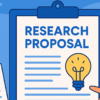
A research proposal is key in securing funding sources such as research scholarships, grants, and fellowships to support your master’s, PhD, or postdoctoral journey. In most cases, a proposal for a research project forms your first impression on master’s or PhD selection committees and postdoc fellowship reviewers, blending precision with vision. Think of it as data-driven storytelling, where your enthusiasm, determination, and plans take center stage. To commence writing one, you must identify a research gap and have a valid research question polished. This article breaks down the general process to help you craft an outstanding proposal for master’s, PhD, or postdoc levels.
Importance of a Strong Research Proposal
A research proposal defines the purpose of your research project, why it is significant, how you plan to address it, and what interfaculty or external research collaboration options it presents. It is an effective tool for persuading research supervisors, departmental selection boards, or grant payers about the value of your idea. The research idea is more about trust than science. Reviewers and referees want to see that you have thought about everything, including feasibility and timing. This is your opportunity to prove that you are planning, not just dreaming. Even great ideas die in the absence of predetermined goals and plans. A strong proposal shapes your career by opening opportunities to research funding and collaborations.

Master’s and PhD vs Postdoc Research Proposals
Since both describe the research problem, objectives, and methodology within a supervised academic framework, master’s and PhD (doctoral) proposals are typically more similar. On the other hand, a PhD proposal is typically more thorough and needs to show uniqueness and potential for advancement in the field. Since postdoctoral proposals are frequently written for grant or fellowship applications, they are very different. Independent research, the applicant’s background, the project’s impact outside of academia, and the funding justification must all be highlighted in a postdoctoral research proposal.
Research Idea’s Novelty and Originality
At the master’s level, your research idea doesn’t need to be highly original, especially if you are preparing the research proposal as a writing sample for research supervisors, instead of a required document for competitive scholarships like the Australia RTP scholarship. For a PhD, originality matters more, but your work can still stay within academic boundaries. For instance, the “How does climate change law impact indigenous rights?” is a good research question if you aim to pursue a PhD in law. Postdoc applications are different, requiring cutting-edge projects that not only advance knowledge but also address real-life challenges and make a difference beyond the academic world.
Research Gap vs Key Research Question
Your research proposal should be grounded in an idea that addresses a gap or unmet need in science, technology, engineering, or pressing topics like renewable energy or cancer treatment. This idea must be driven by a central research question (also called a key research question), ideally linked to a major societal challenge such as climate change, medical devices, or cancer treatment. In addition to a clear research question, you should also ask: “Why is this research question important now?” These fundamental questions form a strong foundation for your proposal’s introduction. A well-targeted research question captures the attention of reviewers and establishes a compelling starting point.

Structure, length, and Components of a Winning Proposal
The structure, length, components, and application process of research proposals vary depending on the type of position (master’s, PhD, or postdoc) and the discipline for which you are writing a research proposal. Take the following items as some examples:
- If you apply as a future candidate for master’s and PhD positions, a research proposal of one to two pages is enough.
- If a master’s or PhD supervisor you are in contact with asks for a writing sample, you can provide a very short research proposal (less than one page) if you do not have any publications or an English-written thesis.
- Different postdoctoral fellowship and grant applications have their own length requirements for a research proposal. For instance, the Marie Curie postdoc fellowship requires a maximum of 10 pages for the proposal, excluding the applicant’s CV.
- While different postdoctoral fellowships might have different structure requirements, master’s and PhD research proposals don’t have such limitations.
- Some postdoc grant applications are filled out through online forms in multiple steps, however, some others should be written offline in a Word File and uploaded as a pdf file.
Title of Research Proposals
Whether you are writing for a master’s, PhD, or postdoc application, a concise, informative, intriguing, and captivating title is essential for a successful research proposal. It usually should be no more than 20 words. A well-crafted title reflects the core idea of your research and grabs the attention of potential supervisors, reviewers, or funding bodies. It should convey the focus of your study while being engaging and specific. Below are strong title examples from actual applications:
- Cancer Therapy Using Active Delivery of Gold Nanoparticles
- Developing Cost-Effective Membrane Technology for a Sustainable and Low-Carbon Future
- Tailoring Polymer Sequence and Dispersity in Blood
These titles effectively summarize the research objective and demonstrate relevance and originality. They show how a title can balance technical precision with broader appeal, helping your proposal stand out. Remember to follow the guidelines provided by the funding source or university, as some may impose limits on the number of characters or words in the title, or prohibit the use of jargon and specialized terms to ensure the content is accessible to a broad audience.
Introduction Section of Research Proposals
Consider starting the introduction with a hook, such as “Climate changes threaten cities” or “Cancer accounts for X% of deaths worldwide”. A non-specialist audience should easily understand it. Conduct a thorough literature review of previous research to support your research question, focusing on a specific challenge or issue and its urgency. This will lead to the introduction of your proposal. For example, a research proposal might examine challenges related to renewable energy and maintaining a clean environment. To highlight the urgency of the issue, the introduction could begin with the following opening if your proposed research focuses on reducing carbon dioxide (CO₂) in the environment:
Providing a sustainable, low-carbon future is a major global challenge in science and technology. Greenhouse gases significantly impact people’s lives by compromising air quality and contributing to global warming and environmental degradation [reference]. The average annual growth rate of global greenhouse gas emissions was 1.5% between 2009 and 2018. In 2018 alone, total emissions reached a staggering 55.3 billion tons [reference]. Therefore, it is crucial to reduce carbon dioxide (CO₂) emissions, one of the major contributors to these challenges.
Next, briefly discuss recent research on the issue, highlighting important findings and remaining gaps in the focused field. For instance, if a proposal examines trends in renewable energy, it may identify gaps in areas such as the expensive industrial mass production of solar panels. At the end of your introduction, clearly and briefly state how your research will address one of these gaps. Applicants should describe the significance of the proposed project, what they aim to achieve, and why it is important in the context of current knowledge and translation. This approach demonstrates that you are knowledgeable about the field and not merely speculating.
If no specific instructions are provided by the funding organization, which is often the case for PhD and master’s applicants, allocate approximately 30% of your research proposal to the introduction section as a good rule of thumb. A professor in the Department of Chemical and Biological Engineering at Monash University suggests this guideline for those seeking a master’s or PhD scholarship in Australia.
Main Body of Research Proposals
The main body of a research proposal largely depends on whether it is intended for a master’s, PhD, or a postdoc grant application. Regardless, you must clearly state your methodologies and methods, budget plan (i.e., common in postdoc grant applications), timeline, and research objectives. Vague objectives can degrade the strength of your proposal. For instance, “evaluating solar panel efficiency and cost in percentage and currency units” is far more effective than simply stating “exploring solar energy”. Clear objectives demonstrate seriousness and focus. Likewise, do not overuse ‘I’ or ‘we’. Additionally, including a schematic figure or diagram of your proposed research can enhance visual understanding.
If no specific instructions are provided by the funding organization, which is often the case for master’s and PhD applicants, allocate approximately 50% of your research proposal to the main body as a good rule of thumb. The same professor (mentioned above) in the Department of Chemical and Biological Engineering at Monash University suggests this guideline for those seeking a PhD or master’s scholarship in Australia.
Conclusion and References of Research Proposals
Thus, the remaining 20% of your proposal should be dedicated to the conclusion and future outlook of the proposed research. Provide a general summary of what you have written, followed by a forward-looking perspective on how your research will address existing gaps in the field. Avoid including specific details, especially regarding methodologies or previously reported data. Finally, include a list of references at the end of your proposal. Below is the reference list from a successful research proposal titled “Microencapsulation of Liquid Sorbent (MECS) for Carbon Capture”, submitted for a PhD scholarship offered by the University of Melbourne, Australia. To create a well-organized reference list like this, consider using a reference management tool such as EndNote.
Reference
[1] Thomas Stocker, ed. Climate change 2013: the physical science basis: Working Group I contribution to the Fifth assessment report of the Intergovernmental Panel on Climate Change. Cambridge University Press, 2014.
[2] Bryce Dutcher, Maohong Fan, and Armistead G. Russell. “Amine-based CO2 capture technology development from the beginning of 2013—A Review.” ACS applied materials & interfaces, 7 (2015): 2137-2148.
[3] Sunkyung Kim, Hu Shi, and Jin Yong Lee. “CO2 absorption mechanism in amine solvents and enhancement of CO2 capture capability in blended amine solvent.” International Journal of Greenhouse Gas Control, 45 (2016): 181-188.
[4] Claus J. Nielsen, Hartmut Herrmann, and Christian Weller. “Atmospheric chemistry and environmental impact of the use of amines in carbon capture and storage (CCS).” Chemical Society Reviews, 19 (2012): 6684-6704.
[5] Alicia J. Reynolds, T. Vincent Verheyen, Samuel B. Adeloju, Erik Meuleman, and Paul Feron. “Towards commercial scale postcombustion capture of CO2 with monoethanolamine solvent: key considerations for solvent management and environmental impacts.” Environmental Science & Technology, 46 (2012): 3643-3654.
[6] Ryan P. Lively, Ronald R. Chance, and William J. Koros. “Enabling low-cost CO2 capture via heat integration.” Industrial & Engineering Chemistry Research 49, no. 16 (2010): 7550-7562.
[7] Rahul Banerjee, Anh Phan, Bo Wang, Carolyn Knobler, Hiroyasu Furukawa, Michael O’Keeffe, and Omar M. Yaghi. “High-throughput synthesis of zeolitic imidazolate frameworks and application to CO2 capture.” Science 319, no. 5865 (2008): 939-943.
Research Proposal Writing Tips for Success
- Brevity with depth wins: Reviewers receive many proposals, so keep yours concise and follow the specific guidelines from the funding body or institution. Cut the fluff and use clear, simple language by avoiding jargon that may disengage busy readers. For instance, say “test water quality” instead of “evaluate aqueous integrity”.
- Know your audience: Tailor your language to your audience because audience awareness is key to success. Academic supervisors expect academic rigor, while funders want practical impact. A proposal written for academic supervisors should show academic depth, so cite relevant theories and use rigorous methods. In contrast, proposals for funding organizations should highlight real-world outcomes like job creation or environmental solutions. Grant panels favor clear, tangible impacts, whereas professors may value methodological complexity. For example, an NSF proposal might cite “a 20% reduction in carbon emissions” but also include detailed methods for academic review.
- Reduce your stress: To avoid writer’s block and reduce last-minute stress, start with a clear problem statement or research objectives. Break the writing process into manageable steps, such as drafting the introduction one day and the methodology the next. Focus on making consistent progress rather than achieving perfection in a single draft. If you are uncertain about feasibility, consider running a small pilot study or seeking feedback from a mentor early in the process.
- Accept the refusal: Rejection is part of the process; take feedback seriously, revise, and reapply. With persistence and a refined approach, a “NO” can often turn into a “YES”.
- Get ideas from successful research proposal examples: You can generate ideas by reviewing previously funded proposals available online or from peers. This is a quick way to get organized, but do not replicate, as originality is essential. For example, if a sample proposal focuses on air pollution, you might shift the topic to water pollution using the same structure or format.
- Prepare a strong CV: Do not forget that your academic CV plays a significant role in influencing the selection committee reviewing your research proposal. Some funding organizations provide specific sections in their application forms for entering CV credentials. Otherwise, you can use Applyindex’s automated, data-driven CV feature located in your profile dashboard.
Common Mistakes to Avoid in Writing Proposals
One of the most frequent pitfalls in research proposals is overambition, i.e., setting goals that far exceed the available time and resources. Instead, aim for realistic, achievable objectives that align with your project’s scope. Another common issue is ignoring basic application requirements such as word limits, formatting, or submission deadlines. A proposal that exceeds word limitations or misses key formatting guidelines can frustrate reviewers and reduce your chances of success. Careless errors or unclear logic can undermine credibility, so proofreading is essential. A well-prepared proposal makes a strong impression.

Finalizing and Submitting Your Research Proposal
Carefully review your research proposal line by line to ensure consistent tense, clear pronoun use, and logical flow without gaps. Ask a friend or advisor to proofread it because fresh eyes can catch errors you might overlook. Pay attention to presentation details like font size, margins, and submitting in the correct format (typically PDF), as these reflect your professionalism. Finally, avoid last-minute technical issues by submitting well before the deadline. Here’s a concise checklist version of the tips for reviewing and submitting your proposal:
- Consistent Tense: Ensure verb tenses are uniform throughout.
- Clear Pronouns: Make it obvious who or what each pronoun refers to.
- Logical Flow: Check for missing steps or ideas that break the coherence.
- Fresh Perspective: Ask a friend, mentor, or advisor to proofread.
- Professional Formatting: Standard font and size (e.g., Times New Roman or Arial, 11–12 pt); Consistent margins; Correct file format (PDF unless otherwise specified).
- Submit Early: Avoid last-minute computer and internet connection issues by submitting early.
Conclusion
A strong research proposal is a strategic tool that can influence your academic and professional future, not just a formality. Your proposal needs to be clear, purposeful, and have attainable objectives. Good proposals start with an attention-grabbing title and introduction, then have a well-organized body that emphasizes workable strategies and significant results. It is crucial to adjust your tone to the audience, whether they are industry-oriented or academic. Your proposal becomes a potent manifestation of your vision if you adhere to the submission guidelines and steer clear of typical errors like overambition or illogical reasoning. In the end, preparation, accuracy, and perseverance are key components of success.
Frequently Asked Questions (FAQs)
What makes a research proposal strong?
Clarity, feasibility, relevance, and alignment with current research gaps, along with a well-defined structure and realistic objectives.
Can I reuse a proposal for different research applications?
Generally, yes! However, you should adapt a proposal’s structure, but it must be tailored to the specific requirements, audience, and objectives of each application.
Are the details of proposals different for master’s, PhD, and postdoc applications?
Yes. In most cases, master’s and PhD proposals share more similarities, while proposals for postdoctoral grant applications differ significantly in structure, depth, and expectations.





0 Comment